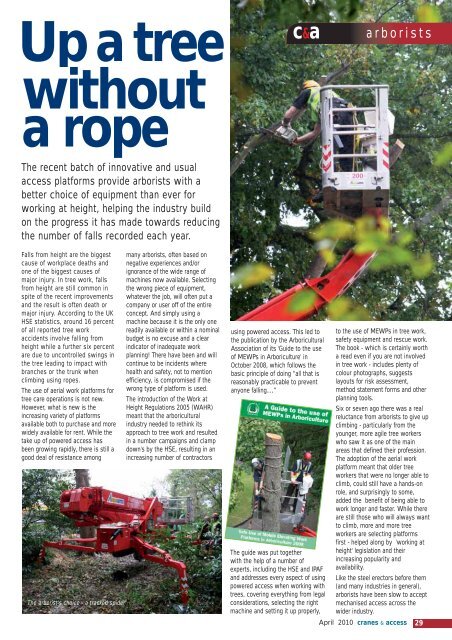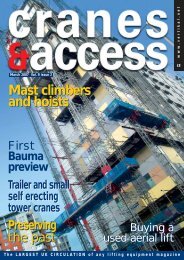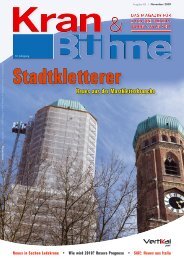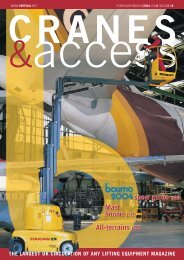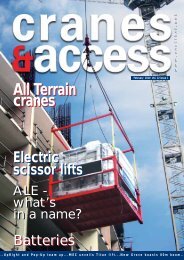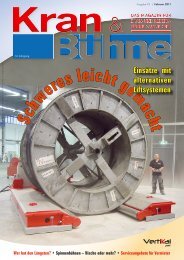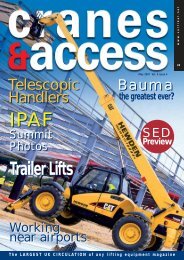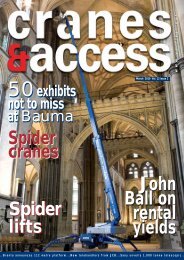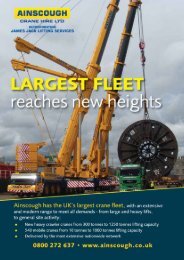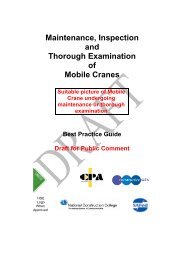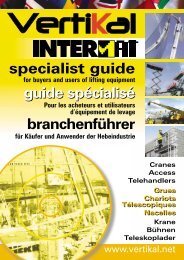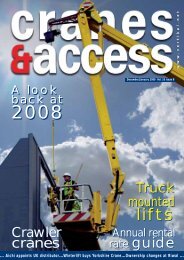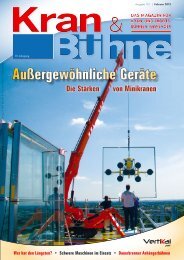Create successful ePaper yourself
Turn your PDF publications into a flip-book with our unique Google optimized e-Paper software.
Up a tree<br />
without<br />
a rope<br />
The recent batch of innovative and usual<br />
access platforms provide arborists with a<br />
better choice of equipment than ever for<br />
working at height, helping the industry build<br />
on the progress it has made towards reducing<br />
the number of falls recorded each year.<br />
Falls from height are the biggest<br />
cause of workplace deaths and<br />
one of the biggest causes of<br />
major injury. In tree work, falls<br />
from height are still common in<br />
spite of the recent improvements<br />
and the result is often death or<br />
major injury. According to the UK<br />
HSE statistics, around 16 percent<br />
of all reported tree work<br />
accidents involve falling from<br />
height while a further six percent<br />
are due to uncontrolled swings in<br />
the tree leading to impact with<br />
branches or the trunk when<br />
climbing using ropes.<br />
The use of aerial work platforms for<br />
tree care operations is not new.<br />
However, what is new is the<br />
increasing variety of platforms<br />
available both to purchase and more<br />
widely available for rent. While the<br />
take up of powered access has<br />
been growing rapidly, there is still a<br />
good deal of resistance among<br />
The arborist’s choice - a tracked spider<br />
many arborists, often based on<br />
negative experiences and/or<br />
ignorance of the wide range of<br />
machines now available. Selecting<br />
the wrong piece of equipment,<br />
whatever the job, will often put a<br />
company or user off of the entire<br />
concept. And simply using a<br />
machine because it is the only one<br />
readily available or within a nominal<br />
budget is no excuse and a clear<br />
indicator of inadequate work<br />
planning! There have been and will<br />
continue to be incidents where<br />
health and safety, not to mention<br />
efficiency, is compromised if the<br />
wrong type of platform is used.<br />
The introduction of the Work at<br />
Height Regulations 2005 (WAHR)<br />
meant that the arboricultural<br />
industry needed to rethink its<br />
approach to tree work and resulted<br />
in a number campaigns and clamp<br />
down's by the HSE, resulting in an<br />
increasing number of contractors<br />
c&a<br />
using powered access. This led to<br />
the publication by the Arboricultural<br />
Association of its 'Guide to the use<br />
of MEWPs in Arboriculture' in<br />
October 2008, which follows the<br />
basic principle of doing “all that is<br />
reasonably practicable to prevent<br />
anyone falling…”<br />
The guide was put together<br />
with the help of a number of<br />
experts, including the HSE and IPAF<br />
and addresses every aspect of using<br />
powered access when working with<br />
trees, covering everything from legal<br />
considerations, selecting the right<br />
machine and setting it up properly,<br />
arborists<br />
to the use of MEWPs in tree work,<br />
safety equipment and rescue work.<br />
The book - which is certainly worth<br />
a read even if you are not involved<br />
in tree work - includes plenty of<br />
colour photographs, suggests<br />
layouts for risk assessment,<br />
method statement forms and other<br />
planning tools.<br />
Six or seven ago there was a real<br />
reluctance from arborists to give up<br />
climbing - particularly from the<br />
younger, more agile tree workers<br />
who saw it as one of the main<br />
areas that defined their profession.<br />
The adoption of the aerial work<br />
platform meant that older tree<br />
workers that were no longer able to<br />
climb, could still have a hands-on<br />
role, and surprisingly to some,<br />
added the benefit of being able to<br />
work longer and faster. While there<br />
are still those who will always want<br />
to climb, more and more tree<br />
workers are selecting platforms<br />
first - helped along by 'working at<br />
height' legislation and their<br />
increasing popularity and<br />
availability.<br />
Like the steel erectors before them<br />
(and many industries in general),<br />
arborists have been slow to accept<br />
mechanised access across the<br />
wider industry.<br />
April 2010 <strong>cranes</strong> & access 29


